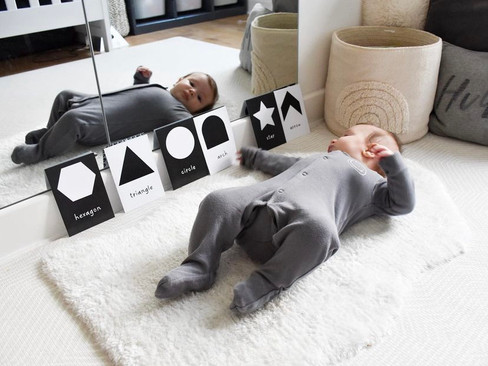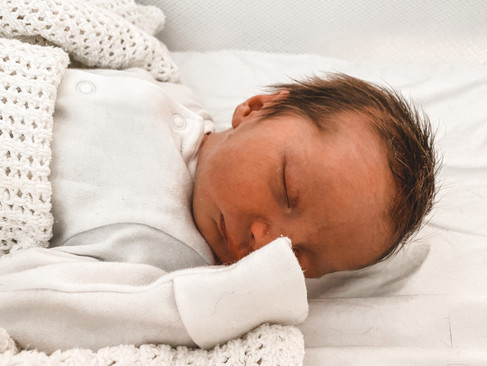Play? With a newborn? How is that possible? And isn't Montessori about preparing their own food or playing with wooden toys? How can a newborn do that?
Montessori is SO much more than just wooden toys. If you read my blog post about three free ways to be more 'Montessori' in your parenting approach, you'll have learnt that Montessori is a lot to do with the approach we as adult take towards children - respectful, and believing that they are capable. This can begin from birth!
The Symbiotic Period
Babies begin learning in the womb, and continue to learn constantly after birth. The first 2 months of your little ones' life is called the 'symbiotic period', which is the time where they are adjusting to life in the world. Rather than 'play' in the sense we all normally think of, newborns need time to connect and spend time together. They need to form that secure attachment with you in order to then continue to grow, develop and flourish in later life. Meeting their needs, following and responding to their cues, recognising whether they are hungry, tired, in need of extra comfort, whether they are too cold, too hot, or overwhelmed are all ways of how we as adults can help our newborn's development in those early days. No newborn is the same. Some will sleep a lot more than others. Some will feed a lot less than others. Some will be more alert and active than others. Some will need more skin-to-skin or adult comfort than others. Respecting our little one as an individual rather than comparing them to others is how we can start their upbringing in a Montessori-inspired way.
Freedom of Movement
Although it does sound a little crazy sometimes when you've got such a teeny, new and precious human in your arms... giving them the freedom of movement by placing them down on a soft mat is actually another way that we as adults can help our little one develop in that symbiotic period. Being able to move their arms and legs will help strengthen their muscles and allow them to begin to make links between the feeling of movement and the movement itself. Sometimes we need to place babies in what Montessori call 'containers', and that's okay. However, bouncers and baby swings don't let them have 'freedom of movement' due to the positions it puts babies into, and therefore are definitely not recommended for long periods of time! Another way to help sensory & motor development is to allow your little one to have bare feet and hands so that they can feel and explore more.

Floor Mirror
Mirrors are a great way to help babies explore, even during the newborn stage. One of the first things we put in Baby I's nursery were two big mirrors on the wall infront of his movement space, and we spent a lot of time lying next to and in front of it during the symbiotic period. For Baby R, I made a portable mirror that can go in his play space whilst he isn't next to a wall. Mirrors help with teaching little ones about cause and effects as they watch their movements in the mirror, and allows them to explore their body through visual touch and reaction in the mirror. Attaching a mirror to the wall, but at child height, also enhances babies' visual development by showing a different 'mirror' image of their space or room. Research has shown that mirrors can also enhance concentration, bring joy to little ones as they love to watch bodily movements and faces of themselves or caregivers, encourages independent play as there is no need to adult interaction - the mirror provides entertainment, and also promotes co-ordinated movement - if your little one sees their arm raise, they're likely to do it again!
Visual Development
We can encourage our babies' visual development too through placing them on a soft mat underneath a mobile. The Montessori Method suggests that there is a progressive sequence of mobiles to introduce to best aid their learning, and this starts with The Munari Mobile which is black and white. I've written all about the Montessori Mobiles HERE (COMING SOON).
The reason the first Montessori Mobile is black and white is because, to begin with, newborns can only see this large contrast in colours because their retina isn't fully developed. The high-contrast registers the strongest in babies' eyes and therefore sends stronger signals to the brain - resulting in brain growth and visual development. In addition to mobiles, you could hang or display flashcards in their eye line or for your baby to look at.
Find Baby Sensory Monochrome Cards in our Shop - or download for free as a Member!
Starting with simple cards, for example a white card with a single black shape on, means that you can then progress to more complex patterns and pictures when you realise your baby becomes less interested in them. We absolutely loved our black and white books from @the_little_bw_book_project - We bought the whole set for Baby I, which include animals from all over the world, with reasonably realistic drawings. They're beautiful!
Narration
One of my favourite features of the Montessori approach that can be started with as newborns, is narrating. I've done this with both babies. Narrating is when you talk through what you are doing, before and as you are doing something. Eg. "We're going to go and change your nappy. I'm going to lift your legs. Ooh look, I've lifted your legs up in the air. Can you feel that?" "Now we're walking down the road back to our home. It's a windy road. Ooh, here comes a bump in the road. Bump. Did you feel that? We went over the bump in the road."
So... all in all... it isn't really 'play' with a newborn in the sense of interacting with toys, but they are learning ALL THE TIME, and all of these ways are suggestions of how we can encourage their development through a Montessori-inspired approach.




























Comentarios